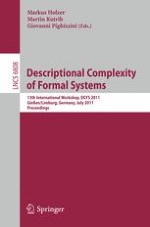This book constitutes the refereed proceedings of the 13th International Workshop of Descriptional Complexity of Formal Systems 2011, held in Limburg, Germany, in July 2011. The 21 revised full papers presented together with 4 invited papers were carefully reviewed and selected from 54 submissions. The topics covered are automata, grammars, languages and related systems, various measures and modes of operations (e.g., determinism and nondeterminism); trade-offs between computational models and/or operations; succinctness of description of (finite) objects; state explosion-like phenomena; circuit complexity of Boolean functions and related measures; resource-bounded or structure-bounded environments; frontiers between decidability and undecidability; universality and reversibility; structural complexity; formal systems for applications (e.g., software reliability, software and hardware testing, modeling of natural languages); nature-motivated (bio-inspired) architectures and unconventional models of computing; Kolmogorov complexity.
